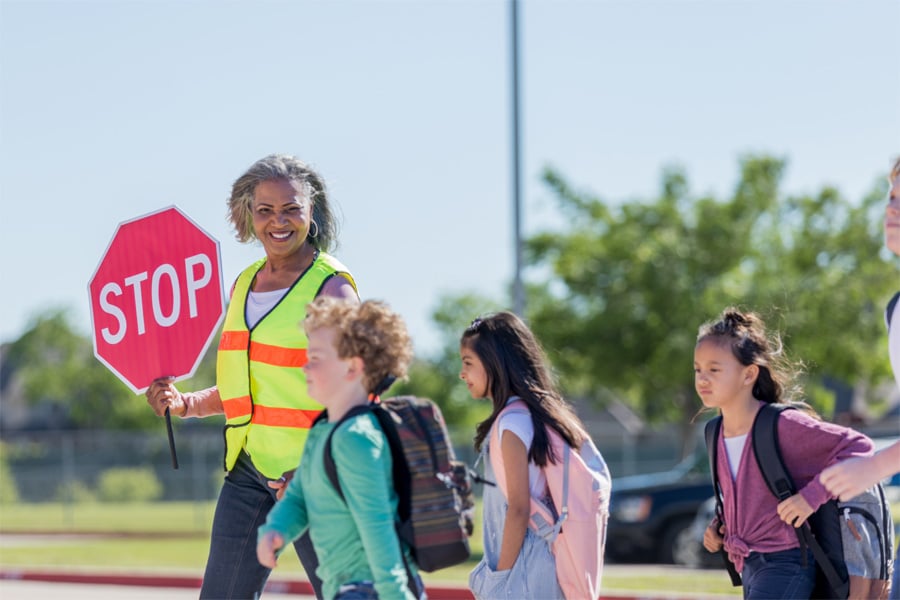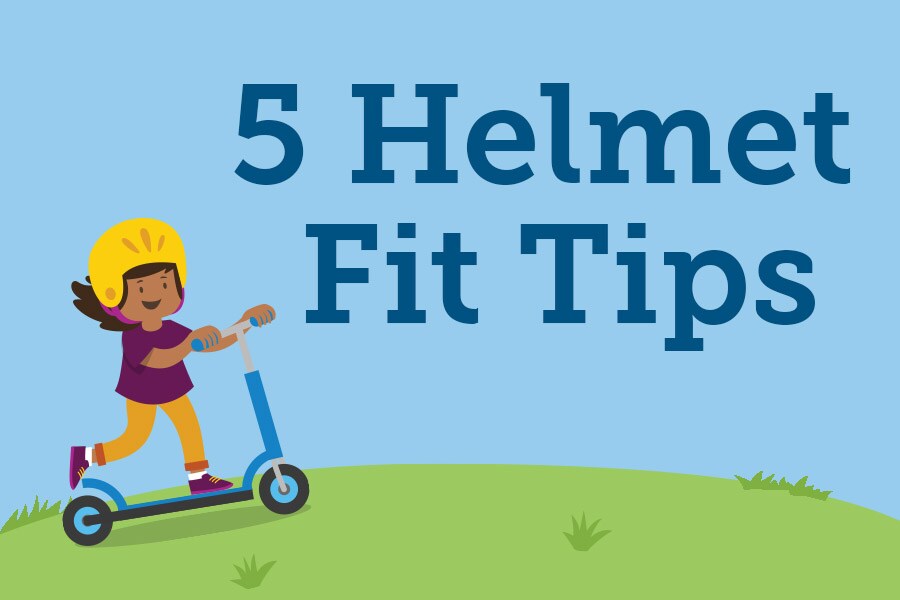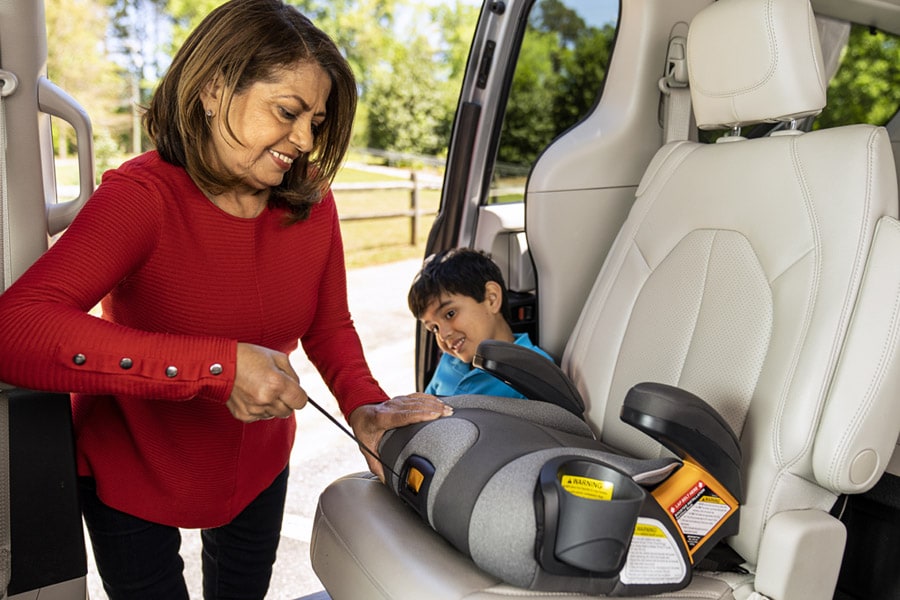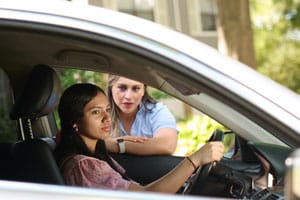Street Smarts: Pedestrian Safety Tips for Kids
From their first steps to walking across the graduation stage, walking is a major milestone for kids. It’s a great way for them to be active and, as they get older, to have some independence. But it’s natural to worry about their safety while they’re on the move.
Unfortunately, 900 children are killed—and many more are injured—each year in pedestrian incidents, according to the American Academy of Pediatrics (AAP). Read on for pedestrian safety tips for kids of all ages.
In this article:

Follow safety rules when biking and taking public transit
It’s equally important to set your child up to stay safe while using other forms of pedestrian travel too, like biking, scootering, roller blading and even public transportation. Here’s a quick look at some of the best ways to stay safe.
Make sure your child is old enough: Younger children are not quite old enough for certain forms of transportation, such as bikes, scooters, motorized scooters, etc., so be sure to follow the age, height and weight guidelines for the equipment they’re using. And when it comes to finding the right product for your child, ensure it’s size-appropriate and fits correctly. Bikes can be especially dangerous if not used appropriately.
Suit up properly: If your child is biking, rollerblading, scootering or skateboarding, they should always wear a helmet and the appropriate knee or elbow pads. If it has wheels, they need a helmet. It’s also important to wear closed-toe, slip-resistant shoes to prevent falls and accidents, and some activities will require even more protective gear, such as wrist guards or goggles.
Follow posted signage: Certain areas of roads and sidewalks are off-limits for skateboards, rollerblades and other modes of transportation, so be sure you and your child follow any markers or directions on the road, bike lane or sidewalk. In most places, riding in the street is the safest place for bikers, but children under 10 should ride on the sidewalk because they aren’t quite ready to handle certain traffic situations.
Stay vigilant when using public transportation: If your older child is taking public transportation, it’s best to teach them some basic rules so they can get from one place to another safely. Here are some of the most important things to remember:
- Encourage your child to ride with a friend or sibling whenever possible.
- Ask your child to always call you when they arrive at their destination.
- Be sure they’re prepared with the exact fare or pass so they don’t have to display cash or a credit card.
- Teach them to sit with their backpack or bag on their lap and have them sit close to the driver or operator whenever possible.
- Make sure they know how to properly use an escalator and that they know it’s not a place for sitting or playing.
- Explain how they should properly stand on the waiting platform: They should stand back from the platform edge and avoid playing and running.
Getting out and commuting is great exercise for your child and allows older kids to develop a little independence. Just make sure they’re prepared to venture out on sidewalks and to public places, both with you and on their own.
If your child has an injury or is showing signs of illness, call your doctor or visit an urgent care center. If your child has a life-threatening injury or illness, is having trouble breathing or is unconscious, call 911 and/or visit an emergency department immediately.

General pedestrian safety rules for kids
No matter your child’s age, walking is great exercise, and it’s free and easy to do. However, whether your child is walking to school, to a friend’s house or just around the block, you’ll want to be sure they make smart decisions and follow general safety rules.
Child pedestrian injury fast facts from the National Institutes of Health:
- Injuries often happen in residential areas.
- Injury often occurs close to the child’s home.
- Most injuries—90% in fact—happen when an adult isn’t present.
To avoid pedestrian injury in kids, it’s important to reinforce safety protocols with your child and practice them while they’re with your or another adult. Here are some of the ways you can protect your child.
Teach your child how to cross the street safely
- Talk to your child about stopping at the curb or edge of the road.
- Teach them to look left-right-left for moving cars before stepping out into the street.
- Show them to wait on the curb or edge of the road if they see a car and repeat looking left-right-left again after the car passes.
- Remember to talk about parking lots, too. Darting out in front of a car, even if it’s parked, can lead to serious injuries.
Watch out for other pedestrians
“Watching out for cars is important, but your child should also be aware of walkers, runners and bikers,” says Michelle Walker, BSN, NPD-BC, CPN, Manager of the Child Advocacy Programs at Children’s Healthcare of Atlanta Strong4Life. “Run-ins with other pedestrians can also cause serious injuries.”
Make sure your child wears bright colors—especially in the evening
If your child is heading out the door, make sure they’re dressed appropriately.
“Dark colors, especially at night, can make it hard for drivers, bikers and other motorists to see your child. It’s best if children avoid going out at night, but if they do, make sure they’re dressed in bright clothing,” says Walker. “If possible, also have them wear a reflective vest and take a flashlight on nighttime strolls.”
Teach them about the risks of talking to strangers:
Teach your child that they should never talk to strangers or anyone that your family does not know well. Discuss “safe strangers” as the only exception to the rule. Safe strangers may include police officers, firefighters and teachers, who can help them if they need it.
“Strangers with bad intentions may try to start a conversation with children or ask them questions to gain their trust,” says Walker. “In those situations, your child should follow the ‘No, Go, Yell, Tell’ protocol. They should say no, run away from the stranger, yell out as loud as they can and find a trusted adult.”
Be extra careful on walks with younger kids
According to the AAP, children younger than 10 should always be accompanied and supervised by an adult when out walking. That’s because younger children are still learning the skills they need to be safe, such as following directions, understanding road signs, and recognizing cars and other hazards.
“You know your child better than anyone, so use your best judgment on when it’s appropriate for your child to venture out on their own,” says Walker. “And until then, make it a habit to hold your child’s hand or closely monitor them, especially in driveways, parking lots and on sidewalks.”
Make sure older kids stay alert while walking
Distracted walking accidents are on the rise, according to the National Safety Council (NSC), and one of the biggest culprits is walking while using a cell phone.
Here’s how to keep older kids safe on the street:
- Stress that staying alert and off their devices could prevent a major accident.
- Explain how quickly an accident can occur, and that they would react more slowly if they’re distracted.
- Talk about putting phones, games, earbuds, headphones, etc. in a bag, backpack or pocket while they’re walking.
- Encourage them to walk with a friend or sibling whenever possible.
- Ensure they wear bright colors, especially at night.
“If your child seems skeptical about the importance of avoiding distractions on the road, try an exercise to show them the risks,” says Walker. “When they’re distracted by a device, try reminding them about an important task, doing something funny or showing them an object. Then ask them to recall what they may have missed.”


